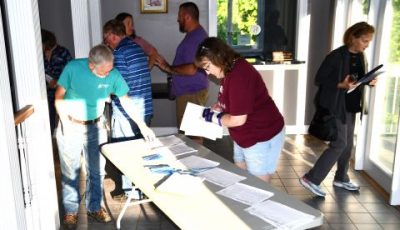New USDA draft environmental assessment does little to change the scope of Jellico Mtn. logging project
Community members are concerned about the lack of changes to the proposed Jellico Mountain logging project outlined in a new draft environmental assessment that was released by the United States Department of Agriculture (USDA) and the U.S. Forest Service last week, which still calls for the clearcutting of nearly 1,000 acres of forest.
Last Wednesday, the USDA uploaded several documents to the project website, www.fs.usda.gov/goto/dbnf/jellico, including specialist reports detailing potential impacts on hydrology, soil, wildlife, socioeconomics, vegetation, climate change and scenery. Most notably, however, the new draft environmental assessment did little to decrease the overall scope of the logging project from the initial proposal released in 2022.
Originally, the USDA proposed work in a nearly 10,000-acre section of land in Whitley and McCreary County portions of the Daniel Boone National Forest. This included just over 1,000 acres of clearcutting, and what could be considered extensive logging on another roughly 4,300 acres. Another point of contention was the proposed timeline of the work, which spanned 40 years, or through the mid-2060s.
As for the new draft proposal, only about 200 acres have been excluded from the overall section of land, and clearcutting has only been decreased by approximately 85 acres. Other forms of logging will still account for over 4,000 acres of the total job, and the timeframe for completion still stands at about 40 years.
The purpose behind the proposal
In the fall of 2022, the USDA cited the following in its initial proposal:
“Overall, the Jellico area is transitioning to mature (81 years and older) forest. Data indicate approximately 72 percent of the project area is mature forest which typically exhibits a closed canopy with an understory and/or midstory layer. Under the current management trajectory, apart from some small (less than 10 acres), isolated areas, the entirety of the area is trending towards mature forest. While desired structures, species compositions, and age classes occur in mature forest, the biodiversity provided by young (0-30 years old) and mid-aged (31-80 years old) forest is being lost.”
“To counteract this loss and increase project area biodiversity by providing a mix of habitat for flora and fauna, action needs to be taken to adjust conditions such that all desired age classes, structures, and species compositions are represented across the area.”
In the new draft proposal released last week, the USDA maintains their position for eliminating old growth forest in order to protect biodiversity provided by less-mature vegetation, adding the following concerning desired condition:
“The overarching goal for this area is habitat diversity; specifically, a diversity of conditions in the form of varying forest communities, structures, and ages. The Proposed Action is designed to generate such diversity through human disturbance in the form of vegetation manipulation.”
“The desired condition is a forest with a vast array of habitat conditions that support the maximum diversity of flora and fauna, while meeting the current and future needs of people,” the proposal added.
Community outcry
In November of 2022, roughly 100 people showed up to a town hall style meeting at the Whitley County Cooperative Extension office in Goldbug. While many were there to voice their concerns about how a job this extensive could have long-lasting negative effects on the local environment, representatives from the forest service were also there to try to convince concerned citizens that the pros of the proposed work would ultimately outweigh the cons.
They were mostly unsuccessful in those efforts.
In addition to the new draft proposal and various environmental specialist reports released last week, the USDA also released a list of responses to comments and objections previously received during a 2022 public comment period. Included in those comments were several from Jim Scheff from Kentucky Heartwood, a conservation group who has been at the center of this debate since it began.
“The scoping document states that the Jellico Project will be implemented over 40 years,” Scheff wrote in one submitted comment. “This timeframe presents numerous problems for the project analysis and approval of any management actions. Foremost is that the project will still be underway implementing the 2004 Forest Plan more than half-a-century after the Plan’s development and over 40 years beyond the Plan’s intended duration as a guiding document.”
A response to Scheff’s comment read, “Forest Plan revisions are expected to occur during project implementation but such revisions are outside the scope of this project.”
Timm Martin joined Scheff in submitting several comments during the public comment period. Among those were, “Does the U.S. Forest Service consider noise and traffic disturbances to neighbors when scheduling treatment jobs?”
The answer to this question was “no” followed by a lengthy explanation.
Martin also asked if the USFS will notify nearby residents when herbicide treatments begin. The answer to this question was “no,” although it was pointed out that signage would be posted in areas where herbicide use is to occur.
Martin also enquired concerning who benefits most from clearcutting, to which he was told, “the impacts and benefits from clearcutting will be analyzed in the Environmental Assessment.”
In all, a total of 144 comments and objections were addressed, and can be viewed in their entirety at www.fs.usda.gov/goto/dbnf/jellico.
What next?
While concerned citizens and conservationists once again reconvene to discuss the best methods for moving forward, a new public comment and objection period is now underway at the above-mentioned web address. The comment period will last through May 24, 2024, and the current estimated decision date is scheduled for sometime this fall.
Community members will have a chance to voice their opinions on the matter in person during a town hall meeting that has been scheduled for Thursday, May 9 at the Merry Jeffries Community Center located at 299 South Second Street in Williamsburg. All are invited to attend






